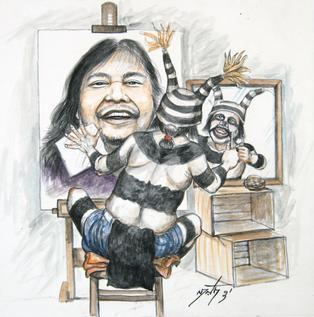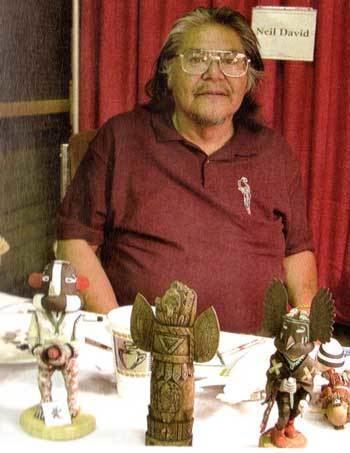Name Neil Sr | ||
 | ||
Neil Randall David, Sr. was a Hopi/Tewa American Indian artist and Kachina doll carver. He learned the basics of carving from his grandfather Victor (Kawayo) Charlie.
Contents

Early life

David was born June 4, 1944 on the Hopi Reservation in Polacca Arizona. His father died before David was six years old. Under the influence and guidance of Victor Charlie, a Kachina doll carver, and his wife, a potter, Lena (Blue Corn) Charlie, David’s interest in art was stimulated at an early age. His grandparents were invited to exhibit their art at the Santa Fe Indian Village pavilion at the Railroad Fair in Chicago in 1948. The following year they brought their grandson, 5 ½ year old David, along with them. David was self-taught as an artist. His art teacher in eighth grade was Fred Kabotie. After graduation, David attended High school in distant Phoenix. He sold his first Kachina doll while a high school freshman to Byron Hunter, who managed the trading store in Polacca. He saw the young man’s talent in art and as his mentor encouraged him. Hunter bought many of David’s drawings, paintings, and Kachina carvings and sold them through McGee’s trading store.
Career
David was drafted into the army in 1965 and served in Germany until 1968. When he returned home he began painting and carving full time. David received national recognition when his paintings and Kachina doll carvings were given multiple page coverage in the Arizona Highways magazine of June 1971, a reference issue devoted entirely to the Kachinas, the Living Spirits of the Hopi. A group of Hopi artists, the Artist Hopid, was organized in 1972 by Michael Kabotie, Terrance Talaswayma, and Neil David Sr. Their objectives included the use of their artistic talents to instill pride and identity in the Hopi, to educate Indian and non-Indian to the cultural values of the Hopi, and document Hopi history and events through the visual arts. In 1974 and 1975 the expanded membership of six exhibited at the Heard Museum in Phoenix; the Tucson Art Center; Riverside Community College in Riverside, California; Museum of Man in San Diego; Taylor Art Museum in Colorado Springs; and the Flagstaff Art Museum. In 1976 the National Endowment for the Arts and the Arizona Commission on the Arts provided a grant sending thirty-one of the groups paintings on a tour across the country. Patricia Broder’s Hopi Painting includes biographical essays of the Artist Hopid and details their exhibits and achievements.
David’s inseparable commingling of art and dedication to his Hopi culture give a rare opportunity to view elements of Hopi life without intruding on the society itself. His insight into his culture, and ability to capture realistic views of Hopi life, ceremonies, and dramatic Kachina dances on canvas and with his Kachina doll carvings have brought him wide acclaim and support for calling him “the Hopis’ Norman Rockwell.” David is internationally recognized for his drawings and carvings of his icon the Koshare, (Tewa or Hano) clown.[1] He speaks through the antics of his clown drawings, and is associated with the Koshare to a level summarized in a telephone conversation between author Zena Pearlstone and Neil David and published in the "About Face" book as part of plate 48:[2] “I along with my patrons see me as associated—even infatuated—with this clown [Koshare], which is the subject of so much of my work.” Two of David’s paintings were selected for the "About Face: Self-portraits by Native American, First Nations, and Inuit Artists" exhibit held at the Wheelwright Museum in Santa Fe, New Mexico which was held from November 2005 through April 2006. Both paintings feature his signature piece, the Koshare as central to the topic along with David. The authors/guest curators of the exhibit and publications closing comments (on page 42) were: "the thought-provoking Hopi Triple Self-Portrait, by artist Neil David Sr., which, we have come to think of as the signature image for this project, so many avenues does it explore." David lives and continues to create his painting and carving on the Hopi Reservation in Polacca on First Mesa, Arizona.
Special Work
The original set of 79 paintings by Neil David, on which the book Kachinas, Spirit Beings of the Hopisee page 11 is based, are now in the collection of Dr. Yasutada Kashiwago, Founder of the Kashiwagi Museum in Tateshina, Nagano, Japan.
David produced all the illustrations in Eric Bromberg’s book The Hopi Approach to the Art of Kachina Doll Carvings. Neil David’s Hopi World[3] published by Schiffer Publishing Ltd., is a collection of over 40 of Neil David’s pen and ink drawings of his interpretation of Hopi history and culture.
Recognition
David was awarded the Arizona Indian Living Treasures AILTA award in 2005. AILTA honors the lifetime achievements of Arizona American Indians.
In November 2013 David was invited to present a series of talks and exhibit his work in Germany. This included visits to the Linden Museum in Stuttgart, the Freiberg Natural History Museum, and Galerie Kokopelli in Mönchengladbach. A documentary film titled: Neil David Sr., A Smiling Hopi, was shown at the Fifth Annual Indian Inuit; North American Native Film Festival which took place in Stuttgart, Germany January 2014. The festival was organized by UNICEF, American Indian Film Institute and Festival in San Francisco, and Dreamspeakers International Indigenous Film Festival Edmonton, Canada.
